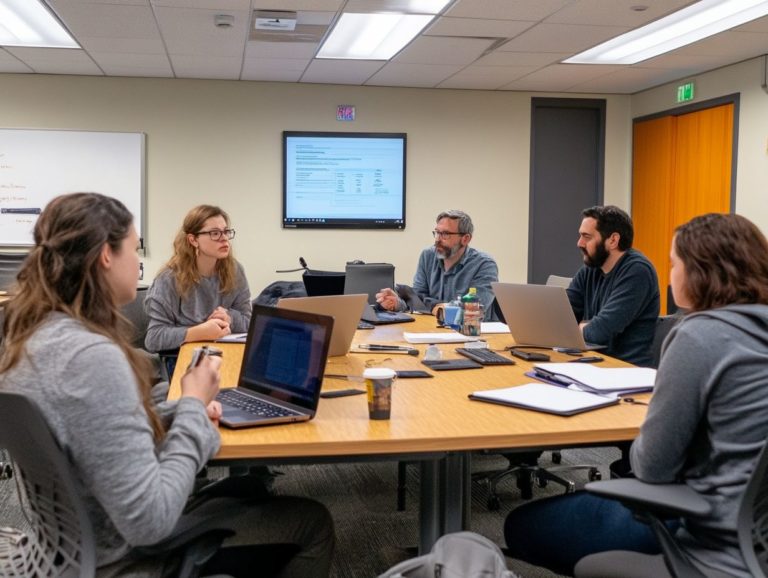Performance Reviews: Best Practices and Tools
Performance reviews are integral to fostering growth and accountability within your teams. They help clarify expectations and promote open communication between employees and management.
This article delves into the significance of performance reviews, illustrating why they matter and how they can propel success. It outlines best practices for conducting effective reviews, from setting clear goals to implementing fair evaluation systems.
Using tools like software and feedback surveys can streamline the review process. This guide will empower you with insights to supercharge your performance review practices.
Contents
- Key Takeaways:
- The Importance of Performance Reviews
- Best Practices for Conducting Performance Reviews
- Tools for Conducting Performance Reviews
- Peer Reviews
- Self-Evaluation Forms
- Frequently Asked Questions
- What are the best practices for conducting performance reviews?
- How often should performance reviews be conducted?
- What tools can be used to conduct performance reviews?
- How do performance reviews benefit employees?
- How can managers ensure fairness in performance reviews?
- What should be included in a performance review discussion?
Key Takeaways:
- Effective performance reviews offer insights into an employee’s strengths and contributions.
- Successful reviews require clear goals, regular feedback, and fair evaluations.
- Tools like evaluation software, feedback surveys, and self-evaluations can streamline the review process.
The Importance of Performance Reviews
Performance reviews are essential for enhancing employee performance and cultivating a culture of transparent communication within your organization. They equip HR leaders and managers with vital insights into employee contributions and performance challenges, allowing for effective management of employee performance.
These reviews create a structured feedback process that fosters employee engagement and promotes career development. This ensures that both employees and managers remain aligned with the organization s strategic goals and developmental roadmap.
Why Conduct Performance Reviews?
Conducting performance reviews is essential for your organization. It provides a structured opportunity to engage in meaningful discussions about employee engagement and the recognition received for contributions to goals and projects.
These discussions do more than just celebrate successes; they also illuminate areas ripe for growth. By fostering a two-way conversation, you can gain invaluable insights from your employees while ensuring they feel heard and valued throughout the process. Goal setting becomes a collaborative effort, aligning individual aspirations with your organizational objectives. Establishing clear performance criteria paves the way for focused improvement, as regular feedback highlights achievements and identifies opportunities for development.
This cyclical approach nurtures a culture of continuous learning and fortifies the relationship between managers and their teams, ultimately boosting workplace morale and productivity.
Best Practices for Conducting Performance Reviews
To truly enhance the effectiveness of performance reviews, you should embrace best practices including clear goal setting, consistent feedback, and a coaching mindset. This approach ensures that expectations are transparent and that performance evaluations are clear and constructive.
Setting Clear Goals and Expectations
Setting clear goals and expectations is essential in performance management. It creates a roadmap for your success and aligns your efforts with the organization’s objectives. This clarity streamlines your contributions and fosters a culture of accountability and motivation.
To effectively establish performance criteria, organizations often employ SMART objectives Specific, Measurable, Achievable, Relevant, and Time-bound ensuring that each target is quantifiable and relatable. Regularly reviewing these metrics allows management to identify trends and pinpoint areas needing improvement, ultimately leading to informed evaluation decisions.
By utilizing key performance indicators (KPIs) tailored to specific roles, you enable objective assessment, promoting continuous development and enhancing overall organizational performance.
Providing Regular Feedback
Regular feedback is essential for effective performance management. It helps you make timely adjustments and fosters continuous improvement.
Informal check-ins, where you and your manager casually discuss your progress, are invaluable. These conversations promote open communication and address any concerns right away.
Consider scheduling structured feedback sessions to create a formal setting for discussing accomplishments and future goals. This coaching mindset encourages meaningful development.
By guiding yourself through challenges and celebrating victories, you embrace feedback and cultivate an environment that encourages professional growth.
Using a Fair and Objective Evaluation System
Employing a fair and objective evaluation system is crucial to minimize bias in performance ratings. It ensures every employee is assessed fairly based on standardized performance metrics.
This means integrating tools that promote consistency and impartiality, enhancing the effectiveness of your evaluation process.
For instance, using feedback from all directions gathering input from peers, managers, and subordinates helps mitigate personal biases.
Utilizing quantitative metrics, like specific target achievements and skill assessments, provides a solid foundation for evaluations.
Regular training sessions for evaluators can raise awareness of unconscious biases, aligning everyone with the organization s commitment to fairness.
Taking a comprehensive approach fosters a culture of transparency, leading to higher morale and productivity.
Tools for Conducting Performance Reviews
Using the right tools for conducting performance reviews significantly elevates the feedback culture within your organization. It streamlines the entire assessment process.
Performance Evaluation Software
Performance evaluation software is a game-changing tool that simplifies your performance management process by automating feedback collection and analytics.
This innovative solution transforms how you gather insights on employee performance, making it easy for HR leaders and managers to synthesize evaluations into actionable data.
With features that enhance real-time feedback and facilitate ongoing conversations about performance, it turns traditional review processes into dynamic, continuous assessments.
By providing detailed metrics and visual dashboards, this software enables you to identify high performers while addressing areas needing improvement. It fosters a culture of development and accountability within your workforce.
360-Degree Feedback Surveys
Feedback from all directions is an invaluable tool for gathering comprehensive performance insights from various sources, including peers, managers, and subordinates.
By seeking input from a diverse array of individuals in your organization, these surveys create a well-rounded view of your strengths and areas for improvement.
The feedback process is constructive and fosters a culture of open communication and continuous development. This holistic perspective helps identify specific skill gaps and training needs.
Ultimately, incorporating such feedback cultivates a more engaged and high-performing workforce, where you and your colleagues feel valued and aware of your growth trajectories.
Peer Reviews
Peer reviews are a powerful tool for building a feedback culture within your teams. They enable colleagues to assess each other s performance with greater insight. This approach allows team members to share valuable insights and fosters a sense of accountability among everyone involved.
When you evaluate your peers, you’ll develop a deeper understanding of each other s strengths and weaknesses. This helps create a more cohesive and harmonious work environment. Embracing peer feedback uncovers various perspectives that traditional top-down assessments might overlook.
This makes the performance management process more comprehensive, providing opportunities for personal growth while reinforcing a culture of collaboration and support that benefits the entire team.
Self-Evaluation Forms
Self-evaluation forms enable you to reflect on your performance, strengths, and areas for improvement, laying the foundation for meaningful performance discussions.
By engaging in this process, you develop a stronger ownership of your professional development. Actively assessing your contributions and identifying skill gaps boosts your self-awareness and promotes open dialogue during evaluations.
This practice is essential. It nurtures an environment of transparency where your strengths are recognized, and growth opportunities are outlined. Ultimately, integrating self-evaluations into the overall performance evaluation process enhances both your journey and the organization s success.
Frequently Asked Questions
What are the best practices for conducting performance reviews?
The best practices include setting clear expectations, providing timely and specific feedback, using a standardized evaluation system, involving employees in the process, and following up on action plans.
How often should performance reviews be conducted?
Performance reviews should be conducted at least once a year. Some companies opt for quarterly or bi-annual reviews to ensure more frequent feedback and goal setting.
What tools can be used to conduct performance reviews?
Common tools for performance reviews include evaluation forms, employee self-assessments, 360-degree feedback, and performance management software.
How do performance reviews benefit employees?
Performance reviews give employees a chance to receive feedback, set goals for improvement, and discuss career development opportunities with their manager.
How can managers ensure fairness in performance reviews?
Managers can ensure fairness by using a standardized evaluation system, providing specific and objective feedback, and involving employees to address potential biases.
What should be included in a performance review discussion?
A review discussion should cover the employee’s accomplishments, areas for improvement, progress towards goals, and career development opportunities. It should also allow for open communication and feedback from both the employee and manager.




